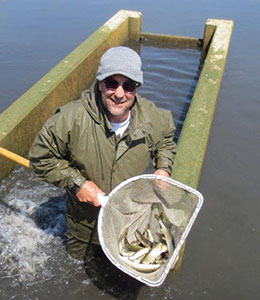By Louie Stout
 Muskie Collection has Hoosier Biologists UneasyIndiana fish biologist Jed Pearson was breathing a sigh of relief last Wednesday, but knew he was hardly out of the woods.
Muskie Collection has Hoosier Biologists UneasyIndiana fish biologist Jed Pearson was breathing a sigh of relief last Wednesday, but knew he was hardly out of the woods.
Pearson is overseeing a muskie egg-taking project on Lake Webster in Kosciusko County. Historically, the brood stock Pearson’s crew collects there provides all of the eggs needed for Indiana’s statewide muskie program.
And that’s what is making Pearson nervous. The lake has been on a downturn the past few years and getting ripe eggs from mature muskies has been tough the past couple of years.
He needs 15 to 20 ripe female muskies to produce the 15,000 muskie sizable fingerlings that the state needs. Last year, the state only captured 11 ripe females and had to set traps at nearby James Lake to fill out their needs.
Wednesday, the first full day of netting, produced 39 muskies that included 7 ripe females. Pearson was pleased, but still needs another dozen or so ripe females.
“It’s encouraging,” he said. “Last year, we only trapped 42 muskies the entire week, so we’re off to a better start. We still have Lake James as a backup if need to go there.”
The DNR sets trap nets in 4 to 6 feet of water on Webster and check the nets daily.
When the nets are emptied, adult fish are taken to a station on the shoreline where eggs are stripped from females and milt taken from males. The fish are then released safely back into the lake. Those fertilized eggs are then transported to a hatchery.
Pearson had other reasons to be encouraged by his first day haul. Aside from seeing several 40-plus-inch muskies, he saw a more 24- 40-inch fish than he has seen in recent years.
“I’m really glad to see those younger fish,” said Pearson. “That tells me the lake is on the rebound, and I’m starting to hear that from fishermen, too.”
The diminishing number of younger muskies was a key reason Indiana revised its stocking program. Instead of planting Webster muskies as 8-10 inchers in the fall, they now hold them in the hatchery longer and feed them minnows.
The fish are then stocked in the spring as 12-13 inchers and when the lake’s forage base is higher. Biologists hope that such a plan will kick start the new muskies’ growth and increase survival.
Ten years ago, Lake Webster was one of the Midwest’s hottest muskie fisheries.
“We’d like to restore its reputation,” he said. “Our stocking program and muskie fishermen depend on it.”
There was other good news from the early netting project. Pearson said several big bass, crappies and bluegill were in the nets. Those also were released alive.
He also noted that perch were spawning on the lake.


